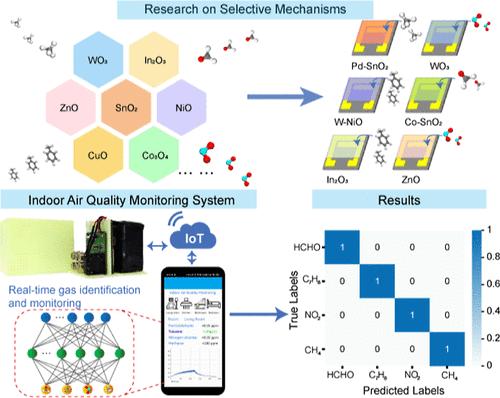Our official English website, www.x-mol.net, welcomes your
feedback! (Note: you will need to create a separate account there.)
Indoor Air Quality Monitoring System with High Accuracy of Gas Classification and Concentration Prediction via Selective Mechanism Research
ACS Sensors ( IF 8.2 ) Pub Date : 2024-11-07 , DOI: 10.1021/acssensors.4c01178 Xueqin Gong, Zhipeng Li, Liupeng Zhao, Tianshuang Wang, Rui Jin, Xu Yan, Fangmeng Liu, Peng Sun, Geyu Lu
ACS Sensors ( IF 8.2 ) Pub Date : 2024-11-07 , DOI: 10.1021/acssensors.4c01178 Xueqin Gong, Zhipeng Li, Liupeng Zhao, Tianshuang Wang, Rui Jin, Xu Yan, Fangmeng Liu, Peng Sun, Geyu Lu

|
The efficacy of sensors, particularly sensor arrays, lies in their selectivity. However, research on selectivity remains notably obscure and scarce. In this work, indoor pollutants (C7H8, HCHO, CH4, and NO2) were chosen as the target gas. Following the screening of six oxides from previous work, temperature-programmed desorption/reduction experiments were conducted to delve into the origins of selectivity. The results explicate the superiority of NiO in detecting toluene and unveil the distinctive NO2 sensing mechanism of WO3 sensors. Based on the sensor array comprising these oxides, it can clearly detect low concentrations of C7H8 (S = 1.6 to 50 ppb), HCHO (S = 1.4 to 50 ppb), and NO2 (S = 3.3 to 50 ppb), which satisfies the requisites of indoor air monitoring. Meanwhile, three machine learning models (Extreme Gradient Boosting, Support Vector Machine, and Back Propagation Neural Network) are employed for gas classification. The classification accuracies of these models are 95.45%, 100%, and 100%, while the R2 values of the concentration prediction are 99.65%, 94.9%, and 98.04%, respectively, indicating the rationality of material selection. Furthermore, it can still achieve relatively high accuracy in gas classification (94.12%) and concentration prediction (89.36%), even for gas mixtures of four gases. Finally, an indoor air quality monitoring system is developed, which enables real-time monitoring of indoor gas quality through the Internet of Things.
中文翻译:

基于选择性机理研究实现高精度气体分类和浓度预测的室内空气质量监测系统
传感器,尤其是传感器阵列,其功效在于其选择性。然而,关于选择性的研究仍然非常模糊和稀缺。在这项工作中,室内污染物 (C7H8、HCHO、CH4 和 NO2) 被选为目标气体。在筛选了先前工作中的六种氧化物之后,进行了程序升温解吸/还原实验,以深入研究选择性的来源。结果阐明了 NiO 在检测甲苯方面的优越性,并揭示了 WO3 传感器独特的 NO2 传感机制。基于包含这些氧化物的传感器阵列,它可以清楚地检测低浓度的 C7H8(S = 1.6 至 50 ppb)、HCHO(S = 1.4 至 50 ppb)和 NO2(S = 3.3 至 50 ppb),满足室内空气监测的要求。同时,三种机器学习模型 (Extreme Gradient Boosting、Support Vector Machine 和 Back Propagation Neural Network) 用于气体分类。这些模型的分类精度分别为 95.45%、100% 和 100%,而浓度预测的 R2 值分别为 99.65%、94.9% 和 98.04%,表明了材料选择的合理性。此外,即使对于四种气体的混合物,它仍然可以在气体分类 (94.12%) 和浓度预测 (89.36%) 方面实现相对较高的精度。最后,开发了室内空气质量监测系统,通过物联网实现对室内气体质量的实时监测。
更新日期:2024-11-08
中文翻译:

基于选择性机理研究实现高精度气体分类和浓度预测的室内空气质量监测系统
传感器,尤其是传感器阵列,其功效在于其选择性。然而,关于选择性的研究仍然非常模糊和稀缺。在这项工作中,室内污染物 (C7H8、HCHO、CH4 和 NO2) 被选为目标气体。在筛选了先前工作中的六种氧化物之后,进行了程序升温解吸/还原实验,以深入研究选择性的来源。结果阐明了 NiO 在检测甲苯方面的优越性,并揭示了 WO3 传感器独特的 NO2 传感机制。基于包含这些氧化物的传感器阵列,它可以清楚地检测低浓度的 C7H8(S = 1.6 至 50 ppb)、HCHO(S = 1.4 至 50 ppb)和 NO2(S = 3.3 至 50 ppb),满足室内空气监测的要求。同时,三种机器学习模型 (Extreme Gradient Boosting、Support Vector Machine 和 Back Propagation Neural Network) 用于气体分类。这些模型的分类精度分别为 95.45%、100% 和 100%,而浓度预测的 R2 值分别为 99.65%、94.9% 和 98.04%,表明了材料选择的合理性。此外,即使对于四种气体的混合物,它仍然可以在气体分类 (94.12%) 和浓度预测 (89.36%) 方面实现相对较高的精度。最后,开发了室内空气质量监测系统,通过物联网实现对室内气体质量的实时监测。


















































 京公网安备 11010802027423号
京公网安备 11010802027423号